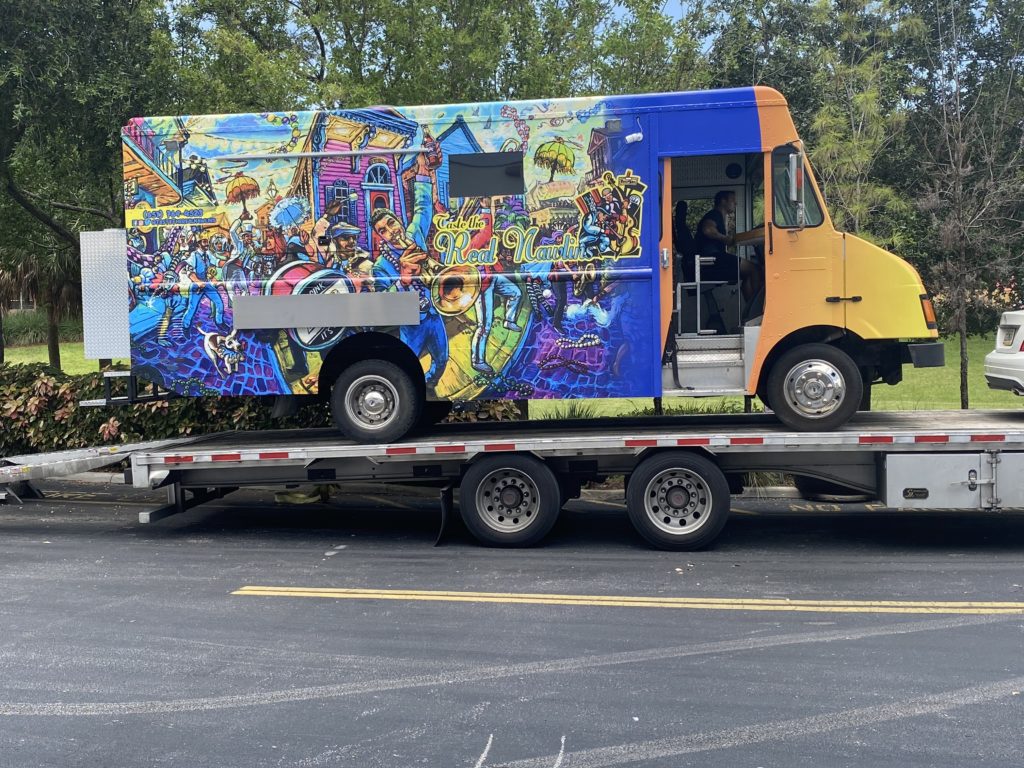How to Load a Food Truck for Transport
Food trucks are designed in different shapes and sizes. Some are rectangular, others are square, while some come in assorted shapes. Similarly, they come in different weights and heights. They are also designed with different frames and axle structures; some are two-wheeled with a hitching mechanism, others are four (or more) wheeled with an engine, and other have a close tandem axle but with no engine to power them. As such, loading a food truck on a trailer for shipping will depend on the specifics of a particular food truck. On the same note, if your food truck is a vehicle or a fifth wheeler, understanding it’s towing capacity is imperative. Whether it’s a short or a long-distance haul, the food truck needs to handle predictably and safely, otherwise moving from one point to the next will be a potential disaster. For this reason, never modify the towing rate of your vehicle and when upgrading your kitchen equipment, always make sure the load is ten percent less the truck’s towing capacity.

Basics of Shipping a Food Truck
Loading a truck food on a trailer and transporting it when the wheels are off the road is the best and safest method. That said, before loading a food truck, you need to know the truck’s specifications; its weight, width, and length. This information will help an expert trucker match the food truck with an appropriate trailer and towing truck in order to avoid overloading. It will also help in determining the number of food trucks that can be loaded on a single trailer. Either long hauls or short hauls, shipping the maximum number of food trucks in a single trip will save both time and money. With the specs in mind, remove any equipment in the food truck that’s not inbuilt; the gas cylinders, utensils, and all personal belongings. This means the weight of the truck will be accurate, weight distribution and balancing while loading the trailer will be easy, and the truck will be free of dangerous equipment such as gas cylinders full of flammable LP gases. Shipping and trucking a food truck can be an easy and smooth transporting process if the driver loads within the weight limits and the truck is adequately secured with chains and straps. Following the guideline for weight distribution, balance, and proper securement is the key to quality shipping and transportation of food trucks.
Preparing a Food Truck for a Flatbed Transport
In some cases, the shipper may be responsible for preparing the truck food ready for shipping. S/he may be required to ensure that the food truck is safe to transport on a flatbed trailer over a long distance. The process is more or less similar to prepping a vehicle for shipping with just a few specific steps for the particular food truck. The food truck manual may have a well dawn guideline, if not, be sure to ask Heavy Haulers for all the requirements prior to relocating the food truck. Early preparation of your food truck for hauling will significantly reduce the chances of potential accidents or damages that could occur during trucking and hauling of your food truck.
Before pulling the food truck up the trailer’s ramps, ensure that there is nothing loose on the floor and no item is hanging from the wall. Afterwards, make sure latches on all doors, cabinets, cargo doors, chains, and windows are well secured. Then inspect all the lights (turn signal, hazards, brakes, and reverse indicator) are working. You may also need to check whether the brakes and parking brakes are working. If all latches are secured, the lights and brakes are working, then conduct a visual inspection to countercheck everything is okay, and the food truck is ready for transport. While going around the truck, ensure all tires are well inflated, and they are in good condition. Tying down a truck with a slow puncture may result in the loosening of the straps and chains, which may lead to the truck wobbling back and forth and sideways moments after the trailer hits the road. This may make the trailer sway or whip, which may likely cause an accident.
Loading a Food Truck on a Trailer for Transport
Park the food truck being towed and the flatbed in line with one another on a levelled surface. Park the towing tractor with the parking brake set, and the trailer’s wheels choked. Drop the ramps and align them with the food truck’s wheels. If the truck has an engine, drive it slowly through the ramps and onto the trailer bed. Make sure you are working with an experienced spotter to guide your movement.
Move the trailer forward until it’s load distribution is perfect for hauling. Heavy Haulers transport experts are highly trained and experienced; they have in-depth knowledge about load distribution and balancing for a smooth shipping and transportation process. If the food truck is two-wheeled and without an engine, use a trailer with a central rail system and a winch to safely load it on the trailer. For large food trucks without an engine, a towing truck is used to pull the food truck up the ramps and onto the flatbed. Depending with the size and weight of a food truck, a trailer can be loaded with more than one truck. Having said that, proper securing of the food truck is crucial to smooth shipping and delivery of the food truck. The ratchets need to be tied down, the wheels strapped, the security chain fastened to the frame, and the body well secured. Luckily, our experts at Heavy Haulers understands the safety measures and the securement process of different food truck designs. With our experts, your food truck will be securely tied down and safely transported to the desired location.

Ready to haul a food truck? Give us a call and let’s get started! (800) 908-6206